My patio is full of plants, and more are on the way. It’s a sure sign of two things: First, a new garden is underway, and second, I am, predictably, quite behind. I always have an excuse for this, but I feel like this year it’s more legitimate than usual. We had a rather significant flood that unfortunately happened one week after we had done all the bed prep for the new garden.
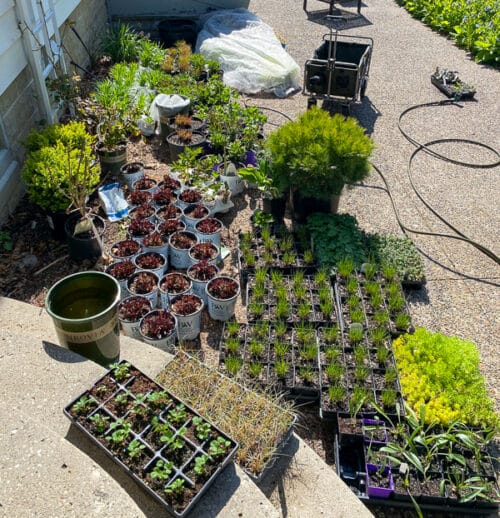
We’re still going back to undo some of that damage, and honestly it could have been so much worse, so we’re very fortunate that it wasn’t. Oddly, I’m not nearly as frantic about how behind I am than I usually would be. Could I actually be getting more patient? Unlikely, frankly.
This pause, however, does give me an opportunity to tell you a little bit about the plants and the plan for this area.
The finished garden area is somewhere around 3,400 square feet. It’s massive. I don’t know that I’ll be able to plant that all this year, but I’d guess that I’ll do at least 75 percent of it. The sheer number of plant varieties going into this garden seems excessive. It may be. But it’s also an enormous area that I think can carry this number of plants.
The design concept might be called dynamic naturalistic, but I don’t think it’s quite that. Perhaps it’s my take on that style. Here’s how I think of it: large swaths of plants and plant matrixes (i.e. typically two varieties planted together to sort of become one) that trickle into one another as though someone knocked the game board table. I don’t want clear definition where one plant starts and another begins, rather an intermingled border. Make sense? If it doesn’t, that’s OK, because I’m not quite sure how that will work until I get in there and start planting.
Without further ado, let’s get to the plant list.
SUN GRASSES
- Sporobolus heterolepis ‘Tara’ (prairie dropseed): Zone 3-9, 2-3′ tall and wide
- Molinia litoralis ‘Transparent’ (moor grass): Zone 4-8, 2-6′ tall x 2-3′ wide
- Andropogon gerardii ‘Blackhawks’ (big bluestem): Zone 3-9, 5′ tall x 2′ wide
- Schizachyrium scoparium ‘Standing Ovation’ (little bluestem): Zone 3-8, 4′ tall x 1′ wide
- Bouteloua gracilis ‘Honeycomb’ (blue grama): Zone 3-10, 30″ tall x 18″ wide
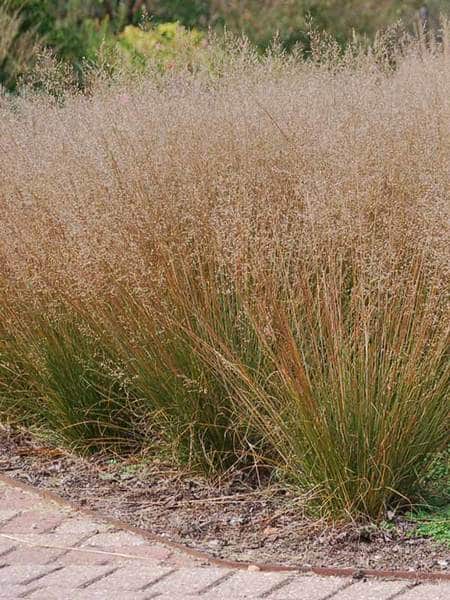
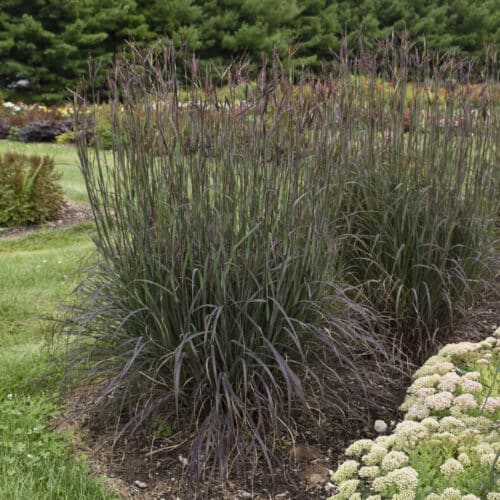
Walters Gardens photo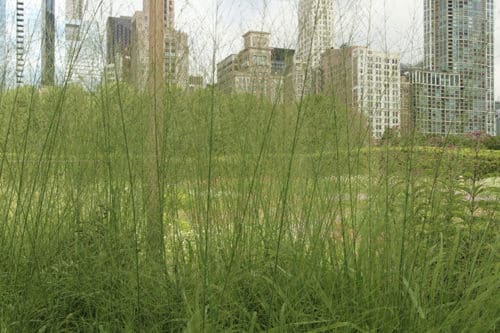
SHADE GRASSES
- Hakonechloa macra ‘Aureola’ (Japanese forest grass): Zone 5-9, 2-3′ tall x 1-2′ wide
- Carex pensylvanica (Pennsylvania sedge): Zone 3-8, 6-12″ tall and wide
- Carex flauca ‘Blue Zinger’ (blue sedge): Zone 5-9, 12-18″ tall and wide
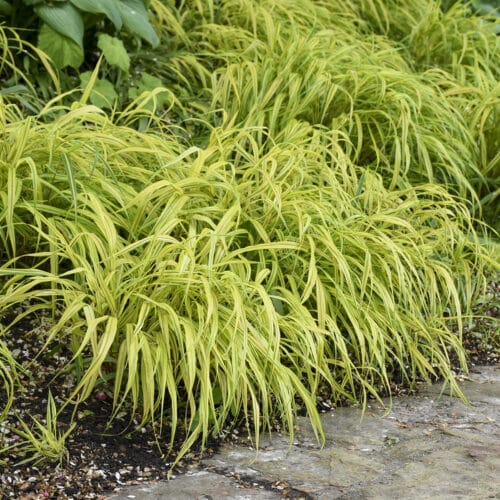
Walters Gardens photo
SUN PERENNIALS
- Penstemon ‘Blackbeard’ (beardtongue): Zone 3-8, 30-36″ tall x 24″ wide
- Alchemilla mollis ‘Thriller’ (lady’s mantle): Zone 3-7, 1-2′ tall and wide (also part shade)
- Nepeta ‘Cat’s Pajamas’ (catmint): Zone 3-8, 12-14″ tall x 18-20″ wide
- Veronicastrum virginicum ‘Queen of Diamonds’ (Culver’s root): Zone 3-8, 4′ tall x 2′ wide
- Liatris spicata (blazing star): Zone 3-8, 2-4′ tall x 12-18″ wide
- Salvia nemerosa ‘Caradonna’: Zone 4-8, 18-24″ tall x 18″ wide
- Stachys x ‘Summer Crush’ (betony): Zone 4-9, 24″ tall x 18″ wide
- Echinacea pallida (pale purple coneflower): Zone 3-10, 2-3′ tall x 12-18″ wide
- Asclepias tuberosa (butterfly weed): Zone 3-9, 12-30″ tall x 12-18″ wide
- Calamintha nepeta ‘Montrose White’ (calamint): Zone 5-9, 12-18″ tall and wide
- Lobelia siphilitica (blue cardinal flower): Zone 4-9, 2-3′ tall x 12-18″ wide
- Pycnanthemum muticum (blunt mountainmint): Zone 4-8, 1-3′ tall and wide
- Sanguisorba hakusanensis ‘Lilac Squirrel’ (burnet): Zone 5-9, 24-30″ tall x 18″ wide
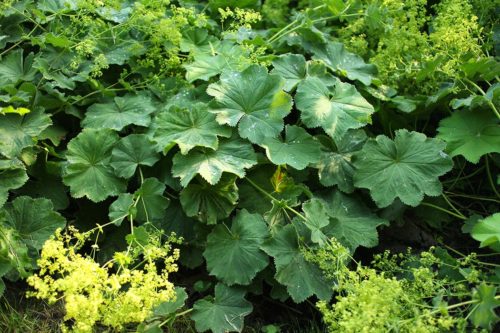
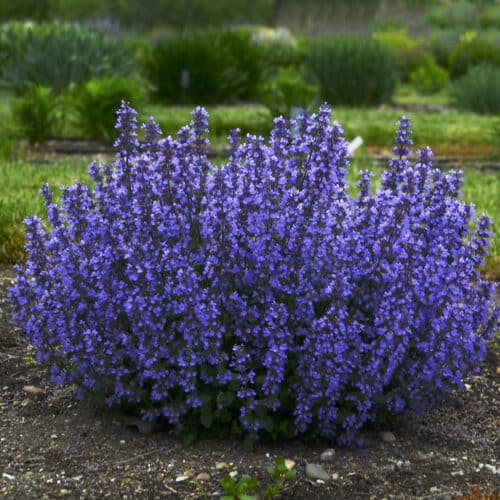
Walters Gardens photo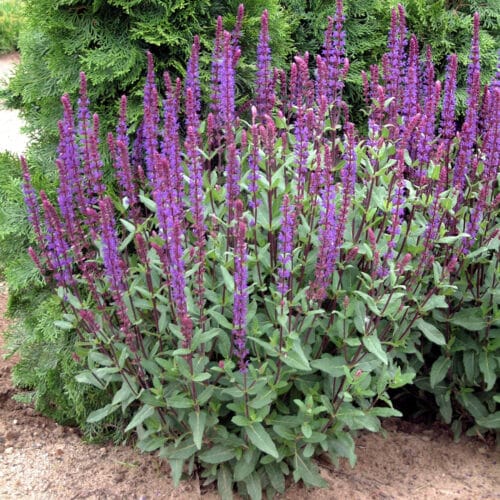
Walters Gardens photo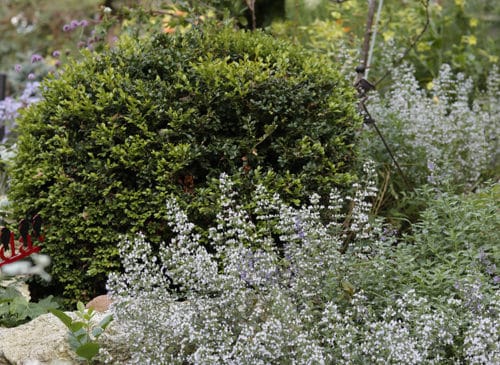
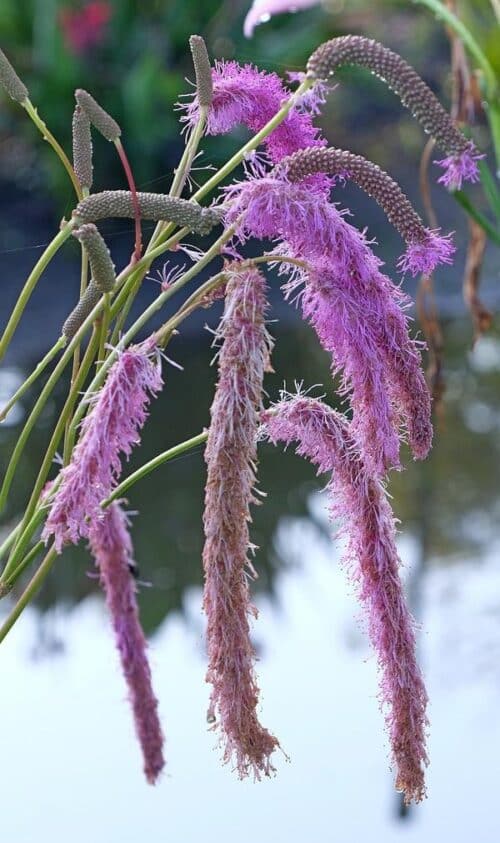
Plant Delights Nursery photo
PART SHADE TO SHADE PERENNIALS
- Heucherella ‘Red Rover’: Zone 4-9, 8″ tall x 18″ wide
- Actaea simplex / Cimicifuga racemosa ‘Brunette’ (bugbane): Zone 3-8, 3-4′ tall x 2-3′ wide
- Aralia cordata ‘Sun King’ (Japanese spikenard): Zone 3-9, 30-36″ tall and wide
- Astilbe chinensis ‘Visions’: Zone 4-9, 18″ tall and wide
- Persicaria amplexicaulis ‘Golden Arrow’ (mountain fleece): Zone 4-7, 2-3′ tall and wide (also sun)
- Athyrium niponicum ‘Crested Surf’ (Japanese painted fern): Zone 3-8, 20-22″ tall x 30″ wide
- Geranium macrorrhizum ‘Bevan’s Variety’ (bigroot geranium): Zone 3-8, 12″ tall x 18-24″ wide
- Thalictrum ‘Elin’ (meadow rue): Zone 4-9, 8′ tall x 2 ‘ wide
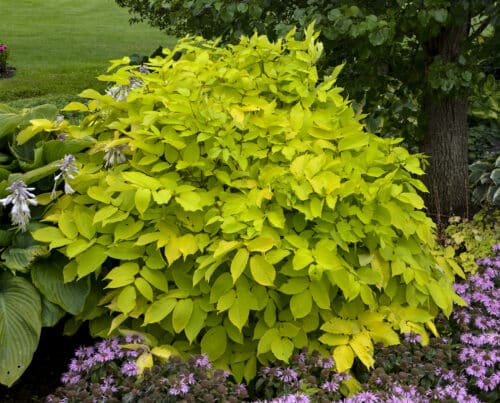
Proven Winners photo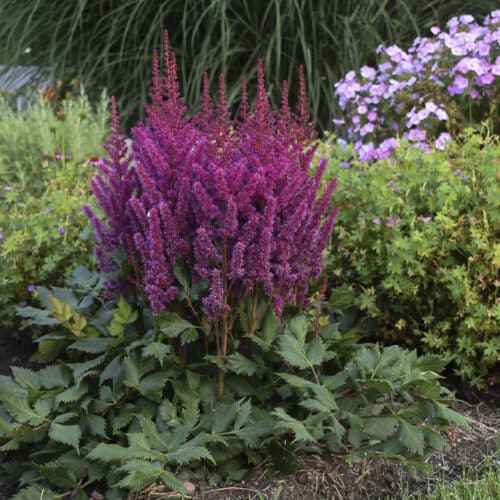
Walters Gardens photo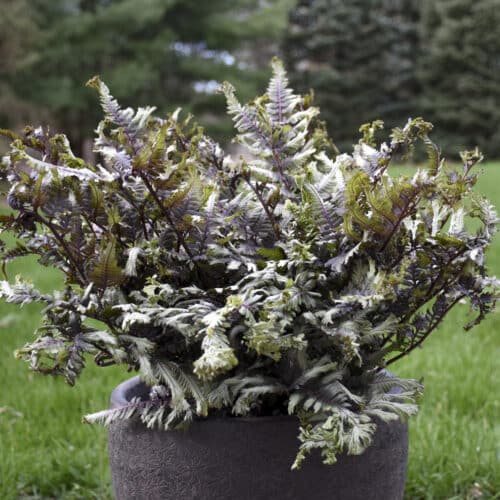
Walters Gardens photo
BIENNIALS AND SELF-SEEDERS
- Foeniculum vulgare (bronze fennel): 4′ tall (may be perennial)
- Angelica gigas : 5-6′ tall x 18-24″ wide
- Digitalis ferruginea (rusty foxglove): 3-5′ tall x 12-18″ wide
TREES AND SHRUBS
- Cornus mas (cornelian cherry dogwood): Zone 4-8, 15-20′ tall and wide
- Pinus strobus ‘Blue Shag’ (Eastern white pine): Zone 3-8, 4′ tall and wide in 10 years
- Amelanchier x grandiflora ‘Autumn Brillance’ (serviceberry): Zone 4-8, 15-25′ tall x 15′ wide
The list is a little light on trees and shrubs. Frankly I hadn’t intended that to be the case but the budget has been decimated and at some point I started to wonder if I needed them. It seemed like an easy way to stop spending for this year and I can always add them later. I wouldn’t mind a weeping katsura in there at some point.
Generally speaking I was looking for deer resistance (hence why you don’t see any hostas), although I know a few of these may be tempting to them. I was also looking for generally low maintenance down the road. I don’t want to do a lot of deadheading or general minding. A big cut back after blooming for the salvia, nepeta and stachys seems reasonable to me.
I always planned to have goldenrod in the mix as well. However I have a lot of native goldenrod growing in this area and I thought that rather than fight it, only to buy a different goldenrod to replace it with, I would see where it wants to grow for a bit and decide if I can make that work.
Spring bulbs, primarily daffodils and alliums, will be a big part of the plan in the future as well, but I’m happy to wait to get a feel for the space before I add those in, so that might be this fall, or maybe next year.
This is not a garden that will come together in one year, but there’s comfort in that when taking on a project this big.


13 Responses
I wanted to pass along a source for plugs.. Greatgardenplants.com. I recently purchased 3 (32) cell trays of blue star creeper. They are $100. ea.
Really nice quality. The plugs are a good 3″ deep. The trays are a bit tricky to push plugs out from the bottom hole. I found it best to use scissors and cut a slit down from the top.
I have no greenhouse..They went directly in the ground around my Yoshino cherry tree. There was a lot of surface roots to deal with. I did add a layer of garden soil and mulch. They weren’t faring too well till I was able to get a grid of 1/4″ drip setup. They’re looking great now.
Hope this is useful.
I second Belle’s suggestion of Solidago ‘Fireworks’, and I dislike goldenrod as a rule!
May we see the naturalistic garden in its ‘sleeping’ stage? It’s always fun to see the before and after pictures, but gardeners love to see the progress from planting time to every stage along the way.
I can”t wait to see it I was wondering if the rabbits eat your echinacea i grew some from
seed this year and rabbits have eaten them all to the ground
I loved this post. You have really thought this out and have a great group of plants. I am looking forward to watching it come together. I am getting rid of a row of Hostas and replacing them with Epimediums, true Geraniums and Hellebores. Hoping for lower maintenance in that spot and a better design. I have Blue Shag and it is doing well.
I love your plant selection – it should turn out beautifully. The Aralia and the Astilbe will look perfect together.
Regarding the goldenrod, I planted “Goldenrod Solidago Fireworks” and it took off the first year. This is year three and I really like it. It has a clumping habit but grows tall (3 ft or so). It blooms the end of summer into fall and the bees love it. It spreads but not aggressively. It’s nice for a large garden. Mine is planted next to Jacob Kline Bee Balm which is just as tall.
Your plant list sounds amazing. I look forward to seeing them in their planting and growth. I remember you filmed your design process which was very helpful. My problem is I have a difficult time in deciding on plants. I want them all.
This will be beautiful and I can’t wait to see it. Thank you.
That’s a huge project Erin, can’t wait to see it! I wish that my hubby would be more onboard with gardening projects I have to fight him tooth and nail. Love your gardens and have a awesome weekend!
Oooooh, I can’t wait to see it! I think it will be fantastic, because I trust your expertise at this. I want to strongly caution you with Carex ‘Blue Zinger’. In pretty short order, that will make an attempt to mow over everything in its path, if it behaves there like it does here. I absolutely love it, but I rip out bunches of it every year because it’s just so aggressive. I’ll be following this, Erin!
Are many of these plants native to your area? A naturalistic garden seems to call for native plants. Being from California, I don’t know your local species, but would love to read more about them.
It’s going to be beautiful. I can picture what you are trying to achieve and the waves of plantings, intermingled with each other, will have a very natural effect. With the tall grasses, I don’t think you will miss the trees and shrubs much because the grasses will still add the needed height. You can always add the trees and shrubs in another year when you have a better feel for how the bed will look. Thank you for sharing the plant list; you have introduced me to some I wasn’t aware of or had overlooked. I especially love Aralia “Sun King”. One word of advice, be careful using native goldenrod. I have found it very invasive in our area of Wisconsin. It has taken over one of my beds and practically smothered out my other perennials. I am constantly fighting to keep it under control. I can’t wait to see how your bed looks later in the summer.
I know it will be outstanding. Piet would be proud of you.